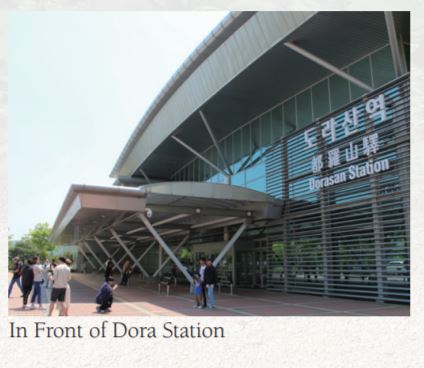The tragedy of a fratricidal war took place in June of 1950 on the Korean peninsula. Though many years have passed since the war, the scars that are left remain in the Demilitarized Zone (DMZ). The DMZ tour is a unique type of tourism that can only be done in Korea. The DMZ tour refers to the sightseeing of the historical sites related to the Korean War and the vivid experience of the reality of national division. As we remember the tragedy of war and wish for peace, the Sungkyun Times (SKT) went on the DMZ tour.
About the DMZ Tour
Introduction of the DMZ and Recent Trends
The DMZ refers to the area where the stationing and arming of military troops are prohibited. After the Korean War, the DMZ was set up around the 38th parallel of the Korean Peninsula following the Korean Armistice Agreement at Panmunjom in 1953. The DMZ is valuable in that it preserves nature well and effectively shows the reality of national division. Recently, since the relationship between North and South Korea has gotten better, the development of government-led tours to the DMZ region is becoming more active.
How to Get to the DMZ
Tour Site There will not be any problem with taking public transportation to Imjingak, which is a park located near Imjingang station. From the Unification Bridge Checkpoint, where tourists must pass for the DMZ tour, however, visitors need to obtain permission from the military base nearby in advance. Therefore, to avoid the inconvenience of going through paperwork procedures, booking the DMZ security tour shuttle bus or DMZ-Train is recommended.
➊ DMZ Security Tour Shuttle Bus
The tour takes about three hours to look around the 3rd Tunnel, Dorasan Station, and Unification Village. The shuttle bus does not operate on Mondays, holidays on weekdays, and pre-bookings are not available; Kingos should book their tickets at the ticket office at Imjingak Tourist Information Center for 9,200 won. There is a designated time limit for sightseeing to every tour spot, and tourists must get on the bus on time. Also, at the Unification Bridge Checkpoint, soldiers get directly on the bus to check individuals’ ID cards and may inspect individuals’ belongings inside the bus.
➋ DMZ-train
There are two lines of the DMZ-Train, but this article covers the Gyeongui Line, which runs between Seoul Station and Dorasan Station. In order to go to Dorasan Station, Kingos need to get their ID cards checked at Imjingang Station. The same as the schedule of the DMZ security tour shuttle bus, the train is not operated on Mondays and holidays on weekdays. Reservations can be made online on the Korail website and the round-trip fee is 17,800 won. There are many DMZ security tour packages offered by various tour companies. Therefore, it is recommended to check and see if there is a better option to suit Kingos.

Beginning of the DMZ Tour
Representative DMZ Tour Sites
Imjingak is a security tour spot located in Paju, near Imjingang station; it is also called Imjingak Park or Resort. This is a good place to look around and relax. There are many things to see in Imjingak, including the Freedom Bridge and Pyeonghwa Nuri Park. Therefore, visiting Imjingak is highly recommended. Kingos can also have a meal at a nearby restaurant. Since there are not many places to eat in the DMZ area, grabbing something to eat before going on the trip would be a smart choice to make.
➊ The 3rd Tunnel
The Ministry of National Defense (MND) found out that there is a tunnel in Paju through intelligence from Kim Bu-seong, a defector from North Korea, in 1974. Until now, four tunnels have been discovered, and the 3rd tunnel is one of them. At the 3rd tunnel, tourists take the train-shaped elevator to get down to the tunnel. Since the height of the tunnel is relatively low, all tourists must wear helmets to protect their heads. In the past, soldiers used to guard the underground tunnel. After the discovery of the tunnel by South Korea, however, North Korea exploded their side of the tunnel because it had lost its ability for a surprise attack. For now, South Korea installed a camera for surveillance.

➋ Dora Observatory
Originally, the Dora Observatory was a military facility designed to observe North Korea. It was opened to the public in 1987 as a security tour site. Inside the facility, Kingos can watch videos and other materials about national security. Dora Observatory provides videos in English for foreign tourists as well. Dora Observation is the closest place where civilians can see North Korea from the South. On the third floor, tourists can see Kaesong Industrial Complex, North Korea’s general posts, and statues of Kim Il-sung, North Korea’s former leader, through the dozens of telescopes if the weather permits. It is impressive to see that North and South Korea’s military bases are so close with just a river flowing between them.
➌ Dorasan Station
Dorasan Station is a train station designed to connect North and South Korea in the future, if or when they are reunified. This place was named after Dorasan near the train station. The sign saying, “Not the last station from the South, but the first station toward the North,” “205km to Pyongyang”, and the firmly closed immigration office reveal the pain of national division and the hope for reunification at the same time. The train platform gate to Pyongyang is a popular photo spot for tourists. With a hope that Dorasan Station will be the starting point of the Eurasian Continental Railway someday, Kingos can stamp the seal of Dorasan Station, which is located next to the ticket booth.

